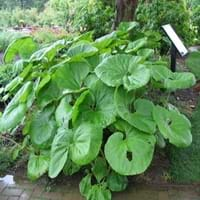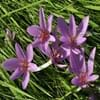Life Span
Perennial
Perennial
Type
Bulb or Corm or Tuber
Herbaceous Perennial
Origin
Hybrid origin
China, Japan, Korea
Types
boissieri , cupanii , hungaricum , kesselringii
Not Available
Number of Varieties
Not Available
Habitat
Temperate Regions
Dappled Shade, meadows, Shady Edge, Sunny Edge, Woodland Garden
USDA Hardiness Zone
Not Available
5-9
AHS Heat Zone
Not Available
9-4
Sunset Zone
21,22
2a, 2b, 3a, 3b, 4, 5, 6, 7, 8, 9, 10, 14, 15, 16, 17, 18, 19, 20, 21, 22, 23, 24
Habit
Clump-Forming
Clump-Forming
Flower Color
Purple, Violet
Light Yellow, Ivory
Flower Color Modifier
Bicolor
Bicolor
Fruit Color
Not Available
Not Available
Leaf Color in Spring
Green
Green
Leaf Color in Summer
Light Green
Green
Leaf Color in Fall
Several shades of Green
Green
Leaf Color in Winter
Light Green
Not Available
Leaf Shape
Long Linear
Ovate
Plant Season
Spring, Fall
Spring, Summer, Fall
Sunlight
Full Sun, Partial Sun
Partial shade, Full Shade
Type of Soil
Loam
Clay, Loam, Sand
The pH of Soil
Acidic, Neutral
Acidic, Neutral, Alkaline
Soil Drainage
Well drained
Poorly Drained
Bloom Time
Late Summer, Early Fall
Early Spring, Late Winter
Tolerances
Drought
Wet Site
Where to Plant?
Ground
Container, Ground, Pot
How to Plant?
Divison, From bulbs, Seedlings
Divison, Seedlings
Plant Maintenance
Medium
Medium
Watering Requirements
Keep ground moist
Water once every two or three weeks
In Summer
Lots of watering
Lots of watering
In Spring
Moderate
Moderate
In Winter
Average Water
Average Water
Soil pH
Acidic, Neutral
Acidic, Neutral, Alkaline
Soil Type
Loam
Clay, Loam, Sand
Soil Drainage Capacity
Well drained
Poorly Drained
Sun Exposure
Full Sun, Partial Sun
Partial shade, Full Shade
Pruning
no pruning required
Remove the old foliage
Fertilizers
All-Purpose Liquid Fertilizer
Use a fertilizer ratio of 16-4-8
Pests and Diseases
Dry root rot, Pest Free
No serious insect or disease problems
Plant Tolerance
Drought
Drought
Flower Petal Number
Single
Not Available
Foliage Texture
Coarse
Bold
Foliage Sheen
Glossy
Glossy
Attracts
Whiteflies
Not Available
Allergy
Poisonous to grazing animals
no allergic reactions
Aesthetic Uses
along a porch, deck or patio, Borders, Mixed Border, small hedge
Bog Garden, Showy Purposes
Beauty Benefits
No Beauty Benefits
Not Available
Environmental Uses
Air purification
Air purification
Medicinal Uses
anti rheumatic, cathartic
Antiasthamatic, Antispasmodic, Expectorant, Poultice
Part of Plant Used
Root
Flowers, Stem
Other Uses
Showy Purposes
Can be boiled and seasoned, pickled, Used as umbrellas by Japanese children, Used as walking sticks, Used like rhubarb
Used As Indoor Plant
No
No
Used As Outdoor Plant
Yes
Yes
Garden Design
Container, Cutflower, Foundation, Lawns and Turf, Mixed Border
Bog Garden, Container, Feature Plant, Water Gardens
Botanical Name
COLCHICUM 'Lilac Wonder'
PETASITES japonicus
Common Name
Hybrid Autumn Crocus, Hybrid Meadow Saffron
Giant Butterbur, Japanese Butterbur
In Hindi
meadow saffron
Giant Butterbur
In German
Herbstzeitlose
Riesen Pestwurz
In French
Colchique d'automne
géant Butterbur
In Spanish
Estado de conservación
gigante petasita
In Greek
meadow saffron
Giant Butterbur
In Portuguese
Colchicum autumnale
Carrapicho gigante
In Polish
Colchicum autumnale
Giant Lepiężnik
In Latin
autumnale
Giant Butterbur
Phylum
Tracheophyta
Magnoliophyta
Class
Magnoliopsida
Magnoliopsida
Family
Liliaceae
Asteraceae
Genus
Colchicum
Petasites
Clade
Angiosperms, Monocots
Angiosperms, Asterids, Eudicots
Tribe
Not Available
Senecioneae
Subfamily
Not Available
Asteroideae
Number of Species
Not Available
Not Available
Season and Care of Meadow Saffron and Giant Butterbur
Season and care of Meadow Saffron and Giant Butterbur is important to know. While considering everything about Meadow Saffron and Giant Butterbur Care, growing season is an essential factor. Meadow Saffron season is Spring and Fall and Giant Butterbur season is Spring and Fall. The type of soil for Meadow Saffron is Loam and for Giant Butterbur is Clay, Loam, Sand while the PH of soil for Meadow Saffron is Acidic, Neutral and for Giant Butterbur is Acidic, Neutral, Alkaline.
Meadow Saffron and Giant Butterbur Physical Information
Meadow Saffron and Giant Butterbur physical information is very important for comparison. Meadow Saffron height is 12.70 cm and width 20.30 cm whereas Giant Butterbur height is 60.00 cm and width 120.00 cm. The color specification of Meadow Saffron and Giant Butterbur are as follows:
Meadow Saffron flower color: Purple and Violet
Meadow Saffron leaf color: Green
Giant Butterbur flower color: Light Yellow and Ivory
- Giant Butterbur leaf color: Green
Care of Meadow Saffron and Giant Butterbur
Care of Meadow Saffron and Giant Butterbur include pruning, fertilizers, watering etc. Meadow Saffron pruning is done no pruning required and Giant Butterbur pruning is done Remove the old foliage. In summer Meadow Saffron needs Lots of watering and in winter, it needs Average Water. Whereas, in summer Giant Butterbur needs Lots of watering and in winter, it needs Average Water.





